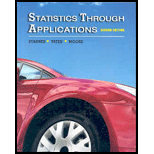
Concept explainers
a)
To find the 99% confidence interval for p
a)
Answer to Problem 9.67RE
The 99% confidence interval is, (6690,7400)
Explanation of Solution
Given:
C=confidence level = 0.99
n =1100
Formula:
Confidence interval for population proportion is,
Sample proportion:
Margin of error:
Calculation:
Sample proportion:
Z critical value can be found either by using standard normal table or excel formula.
Therefore, level of significance = a = 1-0.99 = 0.01
So, Zc =Za/2 = Z0.01/2
Using excel
Zc = 2.58
Therefore, margin of error is,
99% confidence interval for population proportion,
We are 99% confident that the true proportion of teenagers that play games online is between 0.6690 and 0.7400
b)
To explain whether margin of error will be changed for confidence interval of boys and girls.
b)
Answer to Problem 9.67RE
Margin of error will be smaller.
Explanation of Solution
The margin of error will be depending on the sample size. The sample size for girls and boys separately will be smaller than overall sample. Therefore, the margin of error to be larger for smaller sample.
c)
To explain real issues that are not explained by margin of error.
c)
Explanation of Solution
The errors which not included in the margin of error is sampling variability. There are two mainly types of errors. Response bias and non-response bias.
Response bias: In this bias, the responders gives different response than true values.
Non response bias: It occurs when results of not having data for everybody in the sample.
Chapter 9 Solutions
Statistics Through Applications
Additional Math Textbook Solutions
Intro Stats, Books a la Carte Edition (5th Edition)
Introductory Statistics (2nd Edition)
Essentials of Statistics (6th Edition)
Statistical Reasoning for Everyday Life (5th Edition)
Elementary Statistics Using Excel (6th Edition)
Statistics for Business and Economics (13th Edition)
 MATLAB: An Introduction with ApplicationsStatisticsISBN:9781119256830Author:Amos GilatPublisher:John Wiley & Sons Inc
MATLAB: An Introduction with ApplicationsStatisticsISBN:9781119256830Author:Amos GilatPublisher:John Wiley & Sons Inc Probability and Statistics for Engineering and th...StatisticsISBN:9781305251809Author:Jay L. DevorePublisher:Cengage Learning
Probability and Statistics for Engineering and th...StatisticsISBN:9781305251809Author:Jay L. DevorePublisher:Cengage Learning Statistics for The Behavioral Sciences (MindTap C...StatisticsISBN:9781305504912Author:Frederick J Gravetter, Larry B. WallnauPublisher:Cengage Learning
Statistics for The Behavioral Sciences (MindTap C...StatisticsISBN:9781305504912Author:Frederick J Gravetter, Larry B. WallnauPublisher:Cengage Learning Elementary Statistics: Picturing the World (7th E...StatisticsISBN:9780134683416Author:Ron Larson, Betsy FarberPublisher:PEARSON
Elementary Statistics: Picturing the World (7th E...StatisticsISBN:9780134683416Author:Ron Larson, Betsy FarberPublisher:PEARSON The Basic Practice of StatisticsStatisticsISBN:9781319042578Author:David S. Moore, William I. Notz, Michael A. FlignerPublisher:W. H. Freeman
The Basic Practice of StatisticsStatisticsISBN:9781319042578Author:David S. Moore, William I. Notz, Michael A. FlignerPublisher:W. H. Freeman Introduction to the Practice of StatisticsStatisticsISBN:9781319013387Author:David S. Moore, George P. McCabe, Bruce A. CraigPublisher:W. H. Freeman
Introduction to the Practice of StatisticsStatisticsISBN:9781319013387Author:David S. Moore, George P. McCabe, Bruce A. CraigPublisher:W. H. Freeman





